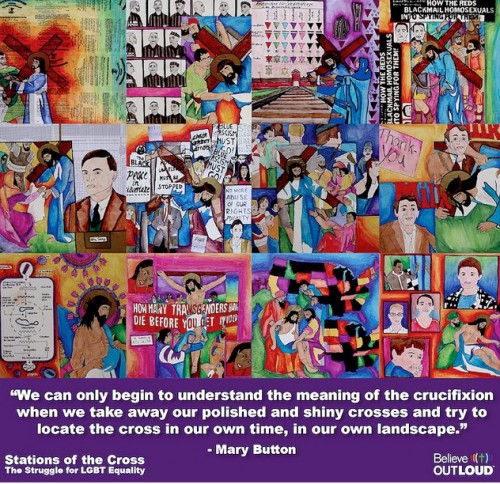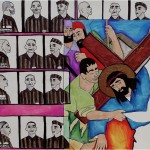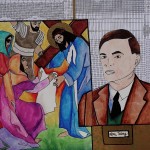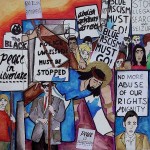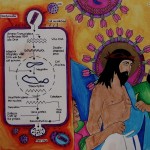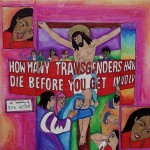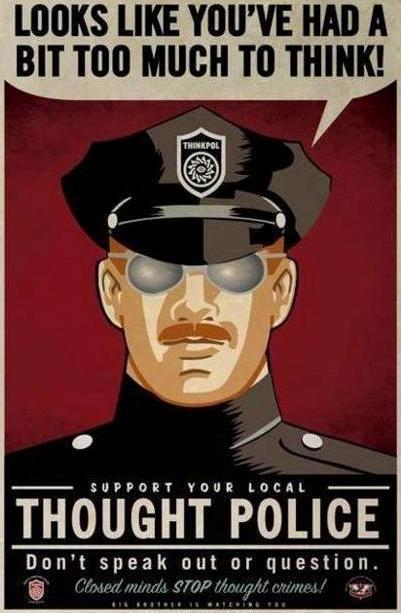Mary Button is the creator of the Stations of the Cross: The Struggle for LGBT Equality. Congregations and faith groups are encouraged to use these stations during the Lenten season for prayer and reflection. Download the entire series from Believe Out Loud’s flickr site.
Secrecy, Sophistry and Gay Sex in the Catholic Church (Book Review)
I am delighted to repost an insightful review of my book that recently appeared in the Quest Bulletin, no. 65 (Winter 2012-13). It now appears on their site, questgaycatholic.org.uk.
By Rev. Dr. Bernárd J. Lynch
Richard Wagner. Secrecy, Sophistry and Gay Sex in the Catholic Church: The Systematic Destruction of an Oblate Priest. ISBN 978-1-61098-212-2
 Jesus tells us “The truth shall set you free.” What he forgot to add ‘It shall also crucify you.’ Richard Wagner would have done well to know this before he set out on the perilous and dangerous study of Gay Catholic Priests: A Study of Cognitive and Affective Dissonance. I have been aware of this study from the early eighties. Nothing had been published before then (1981) concerning the sexual attitudes or behaviours of Catholic priests serving in public ministry. The veil of secrecy surrounding this vocation, as well as the presumption that priests are celibate, has provided a camouflage for the sexually active priest. As this study illustrates, this situation is not without its negative consequences. The sexually active priest is faced with a paradox. The same circumstances that guarantee secrecy also perpetuate the need for secrecy.
Jesus tells us “The truth shall set you free.” What he forgot to add ‘It shall also crucify you.’ Richard Wagner would have done well to know this before he set out on the perilous and dangerous study of Gay Catholic Priests: A Study of Cognitive and Affective Dissonance. I have been aware of this study from the early eighties. Nothing had been published before then (1981) concerning the sexual attitudes or behaviours of Catholic priests serving in public ministry. The veil of secrecy surrounding this vocation, as well as the presumption that priests are celibate, has provided a camouflage for the sexually active priest. As this study illustrates, this situation is not without its negative consequences. The sexually active priest is faced with a paradox. The same circumstances that guarantee secrecy also perpetuate the need for secrecy.
There is a sizable segment of the clergy population that is gay and these men are forced to live duplicitous lives of repression in secret. This often creates an atmosphere of extreme isolation and loneliness that can and does drive these men to desperate measures to find emotional and moral support they should be receiving from their Church. These men love their Church, but hate what it is doing to them. As bad as the situation was back in the early eighties, it is worse today.
Richard Wagner’s groundbreaking research broke the code of silence surrounding this delicate topic. The Church’s single minded effort to quash the emerging story and silence him by getting rid of him is what he writes about in his book Secrecy, Sophistry and Gay Sex in The Catholic Church. The latter part of the book is given over to the actual study that led to what he calls his “systematic destruction as an Oblate priest.” If other priests started coming out of the closet and demanded to be treated with dignity and respect it would certainly undercut the entirety of Catholic sexual moral theology – there is no place for non-reproductive sexuality within that paradigm.
The irony is of course that as Father Wagner was being hounded out of his Religious Order an unimaginable scandal, involving hundreds of Catholic priests, Cardinals, Bishops and Religious Superiors worldwide were and are involved furtively shuffling paedophile priests from one crime scene to another. They were, and still are, involved in a massive corporate cover up of their own crimes and those of their brother clergy. This cover up as has been well documented goes right to the very top and involves the present occupant of the throne of Peter.
The double irony is that the expulsion of Wagner was done “to try and protect the Church from scandal”: THE SCANDAL OF THE SIN OF HONESTY. Honesty about one’s sexuality seems to be the only sin the institutional Church will admit to! The public panic and shameful silencing and worse among Church officials towards openly gay priests – is in stark contrast to the apathetic and anaemic response to the systematic sexual abuse of children that now engulfs the Church.
When Church magisterial teaching about who we are and what we do as LGTB people is based on a lie, then, is it any wonder that the domino effect is disaster. Honesty by Catholic priests about their gayness is punishable by job dismissal. Secrecy lies and deceit are rewarded. The thing that sours all relationship is secrecy. Secrecy eats at the soul. Some people are surprised that religion is so corruptible. They should not be. When secrecy is used to protect a ‘higher order of knowledge,’ it can make the keepers of the secret think of themselves as a higher order of human being. ‘Corruptio optima pessima,’ goes the old saying. Blight at the top is the deepest blight. Most of the hierarchy of the Church are more interested in the Church’s image than the truth in Christ. Twenty years ago I founded a support group for gay Catholic priests and religious here in London. The group is in existence to the present day. We have had well over a hundred priests pass through our doors in that time. Despite numerous efforts and a personal letter from our secretary to the vicar general of the Archdiocese of Westminster we are ignored and refused any publicity of our services by the ecclesiastical authorities. As far as they are concerned ‘we do not exist’ just like the abuse of our most vulnerable children.
Lesbian and gay children until very recently had no models of how to be fully human in an anti-gay world. While in western democracies this is becoming easier, it is not so in the Catholic Church. Our gay priests who by vocation should be ‘alter Christus’ are by force and choice models of the ‘great lie’ . . . When Father Richard Wagner came into the truth of who he is in God’s eyes is it any wonder that a Church that models lies and deceit with regard to its LGBT children casts him out into the wilderness? A wilderness that I hope he finds is alive and flourishing with the freedom of the daughters and sons of God…
Full Review HERE!
You and your friend…
‘Dan Savage vs. NOM’s Brian Brown – the debate’
Priest Argues Catholics Can (And Should) Vote ‘No’ on Minnesota Marriage Inequality Amendment
FATHER BOB PIERSON: As Catholics we must follow our own conscience in
making decisions such as how to vote. My conscience tells me to vote no on the amendment because I have yet to hear a convincing reason why we need such an amendment to our state constitution. In fact, I believe the church does not have the right to force its moral teaching on others outside the fold.
The Gay Debate: The Bible and Homosexuality
Matthew Vines speaks on the theological debate regarding the Bible and the role of gay Christians in the church. Delivered at College Hill United Methodist Church in Wichita, Kansas on March 8, 2012.
Transcript HERE!
Colbert Performs Dramatic Reenactment Of Obama’s ‘War On Religion’
Has this happened to you?
Make Up Your Mind!
Part 5 of a 5-Part Series — Understanding Catholic Moral Theology
This column concludes my series on Roman Catholic moral (sexual) theology. But before I move on to other topics I’d like to leave you with some tips on how you might make up your own mind when grappling with difficult moral issues.
In Part 1 of this series, A Key To Understanding Catholic Moral Theology, I talked about the cornerstone of all Catholic, and indeed all Christian, teaching — the principle of the primacy of one’s conscience. That is, you must follow the sure judgment of your conscience even when, through no fault of your own, it might be mistaken.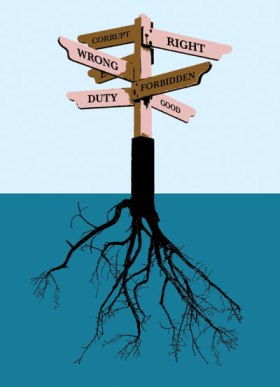
Tip 1 — When faced with a moral dilemma, start with some soul-searching. Your conscience is, in fact, your primary connection with your God. No law, dictum or dogma can take precedence over your conscience. I contend that we don’t need theologians to tell us what is right and wrong or what is just and unjust. We simply need to tap into that simple formula called the golden rule. Deal with others, as you would like others to deal with you. That pretty much covers everything.
As we’ve seen in this series, much of Catholic moral theology is shame based. Shaming is a very effective means of regulating an individual’s behavior so that it conforms to the mores of the group. But capitulating to shame is never the same thing as acting morally. In fact, in many situations the moral thing to do is to stand against the prevailing opinions of the group.
Tip 2 — Try to unravel the system that instills the shame. If you go back to the source of the shaming you will, most likely, discover the reason why the shaming continues. I gave you a good example of this in Part 1 of this series. “To get a handle on Catholic moral theology one must first grasp the depth and breath of it’s institutionalized misogyny.“ Once you uncover the root of the shame you can demythologize it. This will free you up to form your moral decisions less encumbered with dubious communal mores.
Guilt-based theology is dependent on demonizing people or behaviors. When people blindly accept what they are told, they perpetuate the communal mores even if they are unjust or intolerant. Sometimes this becomes so extreme that whole groups of people are vilified often using only stereotypes as evidence of their wrongdoing.
As I pointed out in Part 2 of this series, Sins Of The Flesh, it all begins with language. That’s “wrong”, “dirty”, “bad”, “disordered”, “unnatural” or “intrinsically evil”. In short order this incendiary language becomes a rallying cry that inevitably sets in motion active persecution. Moral maturity, on the other hand, demands that each of us take responsibility for our judgments and prejudices. If nothing more, this process of owning our biases slows down our rush to judgment.
Tip 3 — When faced with a shaming statement, like “that’s wrong”, it’s incumbent upon us ask why it’s wrong and who is making that judgment call. Because if something is “wrong” that means there must be a “right” way. But who gets to determine that, and what are the criteria for making that judgment?
“That’s dirty, disordered, unnatural or intrinsically evil!” Are some body parts or some sexual behaviors more wholesome, more in keeping with the natural order, than others? Again, whose prejudices are at work here?
I suggest that theologians aren’t competent to offer the definitive interpretation of the natural world, but even if they were, we still should ask. How much of your “natural/unnatural” worldview is culturally induced and dependent? Remember, it was once anathema to suggest that the world is round and not the center of the universe.
Finally, Catholicism is not a club. Despite what the hardliners say, lock-step adherence to every facet of church dogma is not what determines ecclesial fellowship. Baptism is! Catholic Christianity is a faith community. That means it’s a living, breathing, malleable thing. Just as I pointed out in Part 4 of this series, Seismic Shift, even the Pope must, from time to time, bow to the currents of culture, history and science.
Tip 4 — Questioning systemic injustice or intolerance in the Church is the right, nay the responsibility, of every believer. And if you find yourself at odds with Church authorities on moral issues, know you are not alone. Catholic women and men of conscience have always been a voice of dissent within the church. Their loyal opposition is precisely what helps keep the hierarchy honest.
Of course the flip side of taking a conscientious stand against the institution can often result in ostracism, shunning and persecution as I pointed out in Part 3 of this series, Sacred Cows. But then again, no one ever said embracing gospel values was gonna be easy.
Seismic Shift
Part 4 of a 5-Part Series — Understanding Catholic Moral Theology
Something earthshaking happened the weekend before Thanksgiving last year. It was so dramatic it was felt right round the globe, don’t cha know.
Pope Benedict made a most extraordinary comment in an interview with the German journalist, Peter Seewald, in July 2010. He said that condom use could be justified in some cases to help stop the spread of AIDS. This startling statement came to light as part of a promotional push for Seewald’s latest book on Cardinal Ratzinger, (now Benedict XVI): Light of the World: The Pope, the Church and the Signs of the Times.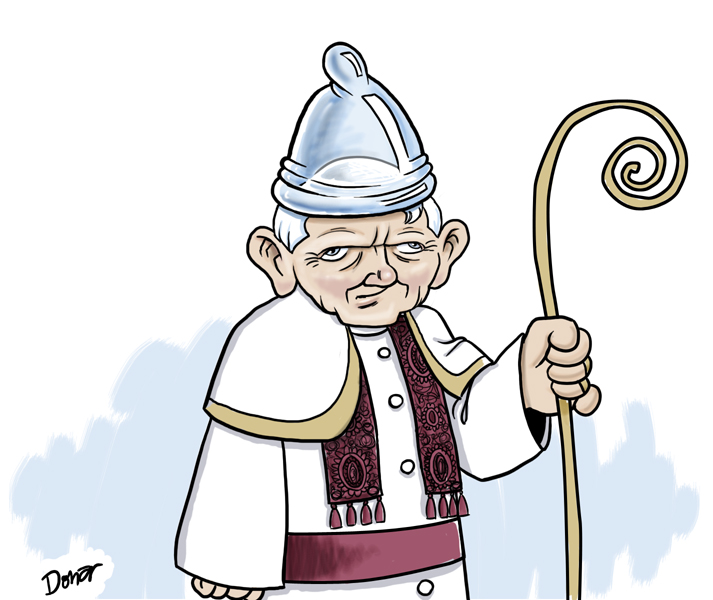
In order to see just how astonishing this is one need only look back to the spring of the previous year. In March, 2009, during his trip to Cameroon, the pope not only reaffirmed Church teaching on the unacceptability of condom use under any circumstance, including the effort to diminish the spread of AIDS. He went on to say that he thought condom use might actually make HIV infection worse. This reiteration of the Vatican’s hard line, especially on African soil, coupled with his casual dismissal of established scientific evidence, drew immediate criticism from around the world. It was yet another public relations nightmare this pontiff didn’t need, or apparently want.
But now Benedict says condoms are not “a real or moral solution” to the AIDS epidemic, adding, “that can really lie only in a humanization of sexuality.” But he also says that “there may be a basis in the case of some individuals, as perhaps when a male prostitute uses a condom, where this can be a first step in the direction of a moralization, a first assumption of responsibility.”
To the avid Vatican watcher this is nothing short of revolutionary. I tell you the Catholic world has shifted on its axis, Benedict’s tortured logic aside.
The week that followed the initial revelation of the pope’s condom statement was a maelstrom. The Vatican curia, bishops from around the world as well as Catholic activists all tried to spin his words. Church conservatives insisted the pontiff had been misquoted or misunderstood. — “The pope’s statement on condoms was extremely limited: he did not approve their use or suggest that the Roman Catholic Church was beginning to back away from its prohibition of birth control” said Fr. Joseph Fessio, SJ, one of Benedict’s former student and editor in chief of the very conservative Ignatius Press. The liberal wing of the Church was hopeful. — “It’s a marvelous victory for common sense,” said Jon O’Brien, the head of the Catholic group — Catholics for Choice.
Then, only a couple of days after the original news broke, more startling information came to light. At a news conference in Rome, papal spokesman, the Fr. Frederico Lombardi, said Benedict knew his comments would provoke intense debate, and that the pope meant for his remarks to apply not just to male prostitutes, but also “if you’re a man, a woman, or a transsexual.”
The pope seemed to be clarifying and expanding his comments, instead of walking them back. At this point, my head began to reel. Had he undergone some kind of metanoya? Did he develop a sense of compassion for male (female and transsexual) prostitutes and their johns? Was he finally having second thoughts about all us sexual reprobates and the damnation that awaits us for our unnatural acts? It was utterly astonishing! And who knew the word transsexual was even in the pope’s vocabulary?
Astonishing, because in October 2010 Belgian Archbishop, André-Joseph Léonard, asserted aloud what most hardliners say in private. He said the worldwide AIDS epidemic is a matter of “immanent justice”, i.e. God’s retribution for sodommite depravity.
By week’s end all hell had broken loose. Many prominent conservative Catholics were publicly rejecting the Vatican’s own explanation of what the pope said. They declared that they would only accept a more formal papal pronouncement, like an encyclical. Liberal Catholics, on the other hand, were taking the pontiff at his word. For them the pope had spoken; exceptions to the Vatican’s previously uncompromising ban on the use of artificial contraception CAN be made in the worldwide effort to combat AIDS.
But what is the average pew Catholic supposed to make of all of this?
The pope is appealing to the principle of double effect, a standard of Catholic moral theology since Thomas Aquinas. This doctrine claims that sometimes it is permissible to bring about, a harmful side effect (contraception) in an effort to promote some greater good (the fight against the spread of AIDS). In other words, accepting the lesser of two evils.
No matter how you look at it, this seemingly innocuous papal statement has created a fissure in the bedrock of Catholic moral theology. It is a total game-changer and nothing will ever be quite the same.
Part 1 of this series HERE!
Part 2 of this series HERE!
Part 3 of this series HERE!

